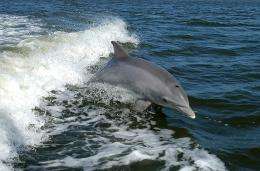From dolphins to dinosaurs -- how fine detail is preserved in fossils

(PhysOrg.com) -- Why do some fossils preserve soft tissue in very fine detail while others most of the detail is lost? After death there is a race against time between soft tissue destruction and mineralisation of the carcass. In some cases soft tissue becomes mineralised in a state similar to the living animal; in others, only bone survives. One theory is that if the body is allowed to dehydrate, for example during a period of drought, and later rehydrated, for example during a flood, the soft tissue may be very well preserved.
Scientists from the University of KwaZulu Nadal and Cardiff University have been using the Diamond Light Source's non-crystalline diffraction beamline I22 to study the decay of collagen in dolphins, turtles and pythons that died of natural caused and were then air-dried to dehydrate them. They hope to understand how dehydration affects the structure of collagen and how this helps preserve a long extinct animal fossil, frozen in time.
Early mineralisation is known to be an important factor in preserving soft tissue, as the tissue can decay rapidly and structural information can be lost. However some fossils, such as those from the Lower Cretaceous Jehol Group in China, are remarkably well preserved. The environment in which the animal dies may affect the level of preservation in many ways. There is a consensus that rapid burial can delay the decay process so that mineralisation occur, and that fossils recovered from sandstone areas have more soft tissue remaining. One explanation for this is in the porous nature of sandstone, which would allow agents of decay like the water content of the tissue and suppurating liquids to drain away, thus leaving the carcase to dehydrate.
Scientists from the University of KwaZulu Nadal and Cardiff University have been looking into the decay processes in collagen from dolphin, turtle and python tissue. Collagen is the dominant protein in animals, making up approximately a third of the protein in most vertebrates. It is known to play a role in early degradation, but exactly how collagen decays is poorly understood. The group used scanning and transmission electron microscopy and small angle X-ray scattering to study air dried and rehydrated samples to look at the structure of collagen and how it was affected by these processes.
They found that the collagen from samples of a dolphin that had been buried for a year and then dehydrated maintained its structural intensity and showed few signs of degradation. The structure of the dolphin collagen fibrils in fact showed remarkable similarity with the collagen structure seen in a 20 - 25,000 year old fossil cartilage. Rehydrating the samples showed little change in the collagen structure, implying that dehydration does extend the time before decay occurs without significant structural damage to the collagen.
Historically large animal mortalities were likely in periods of seasonal drought. Concentrations of animal mortalities are frequent along dried up river beds and close to watering holes, where the carcasses are likely to dehydrate and then be rehydrated during seasonal rains, and rapid burial under silt and mud is also likely, thus meeting conditions for soft tissue preservation.
“Our study has demonstrated plausible scenarios by which soft tissue can be well preserved in ancient fossils. In particular we have seen that extensive dehydration and rehydration can occur without significant structural damage. However, we emphasise that there is no shortcut to understanding the complex processes of preservation in ancient fossils. In future we hope to provide more experimental results, based on modern comparative studies, which will provide further insight into complicated processes of collagen decay,” said Joanna Glab, Cardiff University scientist.
More information:
-- Dehydration: A mechanism for the preservation of fine detail in fossilised soft tissue of ancient terrestrial animals Theagarten Lingam-Soliar, Joanna Glab, Palaeogeography, Palaeoclimatology, Palaeoecology 291 (3-4) DOI:10.1016/j.palaeo.2010.03.019
-- The dinosaurian origin of feathers: perspectives from dolphin (Cetacea) collagen fibers. Theagarten Lingham-Soliar, Naturwissenschaften (2003) 90:563-567. DOI:10.1007/s00114-003-0483-7
Provided by Diamond Light Source

















